
A | B | C | D | E | F | G | H | CH | I | J | K | L | M | N | O | P | Q | R | S | T | U | V | W | X | Y | Z | 0 | 1 | 2 | 3 | 4 | 5 | 6 | 7 | 8 | 9
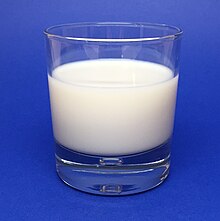
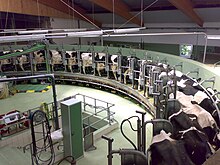
Milk is a white liquid food produced by the mammary glands of mammals. It is the primary source of nutrition for young mammals (including breastfed human infants) before they are able to digest solid food.[1] Immune factors and immune-modulating components in milk contribute to milk immunity. Early-lactation milk, which is called colostrum, contains antibodies that strengthen the immune system and thus reduce the risk of many diseases. Milk contains many nutrients, including calcium and protein, but also lactose and saturated fat.[2]
As an agricultural product, dairy milk is collected from farm animals. In 2011, dairy farms produced around 730 million tonnes (800 million short tons) of milk[3] from 260 million dairy cows.[4] India is the world's largest producer of milk and the leading exporter of skimmed milk powder, but it exports few other milk products.[5][6] Because there is an ever-increasing demand for dairy products in India, it could eventually become a net importer of dairy products.[7] New Zealand, Germany, and the Netherlands are the largest exporters of milk products.[8] The US Centers for Disease Control and Prevention recommends that children over the age of 12 months should have two servings of dairy milk products a day.[9]
More than six billion people worldwide consume milk and milk products, and between 750 and 900 million people live in dairy-farming households.[10]
Etymology and terminology
The term milk comes from "Old English meoluc (West Saxon), milc (Anglian), from Proto-Germanic *meluks "milk" (source also of Old Norse mjolk, Old Frisian melok, Old Saxon miluk, Dutch melk, Old High German miluh, German Milch, Gothic miluks)".[11]
Since 1961, the term milk has been defined under Codex Alimentarius standards as "the normal mammary secretion of milking animals obtained from one or more milkings without either addition to it or extraction from it, intended for consumption as liquid milk or for further processing."[12] The term dairy refers to animal milk and animal milk production.
Types of consumption
There are two distinct categories of milk consumption: all infant mammals drink milk directly from their mothers' bodies, and it is their primary source of nutrition; and humans obtain milk from other mammals for consumption by humans of all ages, as one component of a varied diet.
Nutrition for infant mammals

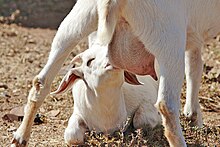
In almost all mammals, milk is fed to infants through breastfeeding, either directly or by expressing the milk to be stored and consumed later. The early milk from mammals is called colostrum. Colostrum contains antibodies that provide protection to the newborn baby as well as nutrients and growth factors.[13] The makeup of the colostrum and the period of secretion varies from species to species.[14]
For humans, the World Health Organization recommends exclusive breastfeeding for six months and breastfeeding in addition to other food for up to two years of age or more.[15] In some cultures it is common to breastfeed children for three to five years, and the period may be longer.[16]
Fresh goats' milk is sometimes substituted for breast milk, which introduces the risk of the child developing electrolyte imbalances, metabolic acidosis, megaloblastic anemia, and a host of allergic reactions.[17]
Food product for humans

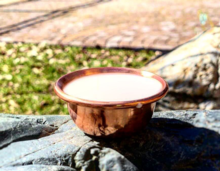

In many cultures, especially in the West, humans continue to consume milk beyond infancy, using the milk of other mammals (especially cattle, goats and sheep) as a food product. Initially, the ability to digest milk was limited to children as adults did not produce lactase, an enzyme necessary for digesting the lactose in milk. People therefore converted milk to curd, cheese, and other products to reduce the levels of lactose. Thousands of years ago, a chance mutation spread in human populations in northwestern Europe that enabled the production of lactase in adulthood. This mutation allowed milk to be used as a new source of nutrition which could sustain populations when other food sources failed.[18] Milk is processed into a variety of products such as cream, butter, yogurt, kefir, ice cream and cheese. Modern industrial processes use milk to produce casein, whey protein, lactose, condensed milk, powdered milk, and many other food-additives and industrial products.
Whole milk, butter, and cream have high levels of saturated fat.[19][20] The sugar lactose is found only in milk, and possibly in forsythia flowers and a few tropical shrubs.[21] Lactase, the enzyme needed to digest lactose, reaches its highest levels in the human small intestine immediately after birth, and then begins a slow decline unless milk is consumed regularly.[22] Those groups who continue to tolerate milk have often exercised great creativity in using the milk of domesticated ungulates, not only cattle, but also sheep, goats, yaks, water buffalo, horses, reindeer and camels. India is the largest producer and consumer of cattle milk and buffalo milk in the world.[23]
| Country | Milk (liters) | Cheese (kg) | Butter (kg) |
|---|---|---|---|
| 135.6 | 6.7 | 2.4 | |
| 127.0 | 22.5 | 4.1 | |
| 105.9 | 10.9 | 3.0 | |
| 105.3 | 11.7 | 4.0 | |
| 90.1 | 19.1 | 1.7 | |
| 78.4 | 12.3 | 2.5 | |
| 75.8 | 15.1 | 2.8 | |
| 62.8 | 17.1 | 3.6 | |
| 55.7 | 3.6 | 0.4 | |
| 55.5 | 26.3 | 7.5 | |
| 54.2 | 21.8 | 2.3 | |
| 51.8 | 22.9 | 5.9 | |
| 49.1 | 23.4 | 0.7 | |
| 47.5 | 19.4 | 3.3 | |
| 39.5 | – | 3.5 | |
| 9.1 | – | 0.1 |
History

Humans first learned to consume the milk of other mammals regularly following the domestication of animals during the Neolithic Revolution or the development of agriculture. This development occurred independently in several global locations from as early as 9000–7000 BC in Mesopotamia[25] to 3500–3000 BC in the Americas.[26] People first domesticated the most important dairy animals – cattle, sheep and goats – in Southwest Asia, although domestic cattle had been independently derived from wild aurochs populations several times since.[27] Initially animals were kept for meat, and archaeologist Andrew Sherratt has suggested that dairying, along with the exploitation of domestic animals for hair and labor, began much later in a separate secondary products revolution in the fourth millennium BC.[28] Sherratt's model is not supported by recent findings, based on the analysis of lipid residue in prehistoric pottery, that shows that dairying was practiced in the early phases of agriculture in Southwest Asia, by at least the seventh millennium BC.[29][30]
From Southwest Asia domestic dairy animals spread to Europe (beginning around 7000 BC but did not reach Britain and Scandinavia until after 4000 BC),[31] and South Asia (7000–5500 BC).[32] The first farmers in central Europe[33] and Britain[34] milked their animals. Pastoral and pastoral nomadic economies, which rely predominantly or exclusively on domestic animals and their products rather than crop farming, were developed as European farmers moved into the Pontic–Caspian steppe in the fourth millennium BC, and subsequently spread across much of the Eurasian steppe.[35] Sheep and goats were introduced to Africa from Southwest Asia, but African cattle may have been independently domesticated around 7000–6000 BC.[36] Camels, domesticated in central Arabia in the fourth millennium BC, have also been used as dairy animals in North Africa and the Arabian Peninsula.[37] The earliest Egyptian records of burn treatments describe burn dressings using milk from mothers of male babies.[38] In the rest of the world (i.e., East and Southeast Asia, the Americas and Australia), milk and dairy products were historically not a large part of the diet, either because they remained populated by hunter-gatherers who did not keep animals or the local agricultural economies did not include domesticated dairy species. Milk consumption became common in these regions comparatively recently, as a consequence of European colonialism and political domination over much of the world in the last 500 years.
In the Middle Ages, milk was called the "virtuous white liquor" because alcoholic beverages were safer to consume than the water generally available.[39] Incorrectly thought to be blood diverted from the womb to the breast, it was also known as "white blood", and treated like blood for religious dietary purposes and in humoral theory.[40]
James Rosier's record of the 1605 voyage made by George Weymouth to New England reported that the Wabanaki people Weymouth captured in Maine milked "Rain-Deere and Fallo-Deere." But Journalist Avery Yale Kamila and food historians said Rosier "misinterpreted the evidence." Historians report the Wabanaki did not domesticate deer.[41][42] The tribes of the northern woodlands have historically been making nut milk.[43] Cows were imported to New England in 1624.[44]
Industrialization

The growth in urban population, coupled with the expansion of the railway network in the mid-19th century, brought about a revolution in milk production and supply. Individual railway firms began transporting milk from rural areas to London from the 1840s and 1850s. Possibly the first such instance was in 1846, when St Thomas's Hospital in Southwark contracted with milk suppliers outside London to ship milk by rail.[45] The Great Western Railway was an early and enthusiastic adopter, and began to transport milk into London from Maidenhead in 1860, despite much criticism. By 1900, the company was transporting over 25 million imperial gallons (110 million litres; 30 million US gallons) annually.[46] The milk trade grew slowly through the 1860s, but went through a period of extensive, structural change in the 1870s and 1880s.

Urban demand began to grow, as consumer purchasing power increased and milk became regarded as a required daily commodity. Over the last three decades of the 19th century, demand for milk in most parts of the country doubled or, in some cases, tripled. Legislation in 1875 made the adulteration of milk illegal – This combined with a marketing campaign to change the image of milk. The proportion of rural imports by rail as a percentage of total milk consumption in London grew from under 5% in the 1860s to over 96% by the early 20th century. By that point, the supply system for milk was the most highly organized and integrated of any food product.[45] Milk was analyzed for infection with tuberculosis. In 1907 180 samples were tested in Birmingham and 13.3% were found to be infected.[47]
The first glass bottle packaging for milk was used in the 1870s. The first company to do so may have been the New York Dairy Company in 1877. The Express Dairy Company in England began glass bottle production in 1880. In 1884, Hervey Thatcher, an American inventor from New York, invented a glass milk bottle, called "Thatcher's Common Sense Milk Jar," which was sealed with a waxed paper disk.[48] In 1932, plastic-coated paper milk cartons were introduced commercially.[48]
In 1863, French chemist and biologist Louis Pasteur invented pasteurization, a method of killing harmful bacteria in beverages and food products.[48] He developed this method while on summer vacation in Arbois, to remedy the frequent acidity of the local wines.[49] He found out experimentally that it is sufficient to heat a young wine to only about 50–60 °C (122–140 °F) for a brief time to kill the microbes, and that the wine could be nevertheless properly aged without sacrificing the final quality.[49] In honor of Pasteur, the process became known as "pasteurization". Pasteurization was originally used as a way of preventing wine and beer from souring.[50] Commercial pasteurizing equipment was produced in Germany in the 1880s, and producers adopted the process in Copenhagen and Stockholm by 1885.[51][52]
Sources
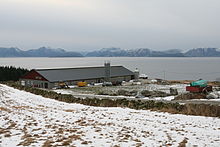
All mammal species have females who can produce milk for some time after giving birth. Cow milk dominates the amount of milk produced. In 2011, FAO estimates 85% of all milk worldwide was produced from cows.[53] Human milk is not produced or distributed industrially or commercially; however, human milk banks collect donated human breastmilk and redistribute it to infants who may benefit from human milk for various reasons (premature neonates, babies with allergies, metabolic diseases, etc.) but who cannot breastfeed.[54] Actual inability to produce enough milk is rare, with studies showing that mothers from malnourished regions still produce amounts of milk of similar quality to that of mothers in developed countries.[55][56][57] There are many reasons a mother may not produce enough breast milk.[58][59][60] The amount of milk produced depends on how often the mother is nursing and/or pumping: the more the mother nurses her baby or pumps, the more milk is produced.[61][62][63][64]
In the Western world, cow's milk is produced on an industrial scale and is, by far, the most commonly consumed form of milk. Commercial dairy farming using automated milking equipment produces the vast majority of milk in developed countries. Dairy cattle, such as the Holstein, have been bred selectively for increased milk production. About 90% of the dairy cows in the United States and 85% in Great Britain are Holsteins.[22] Other dairy cows in the United States include Ayrshire, Brown Swiss, Guernsey, Jersey and Milking Shorthorn (Dairy Shorthorn).
Other animal-based sources
Aside from cattle, many kinds of livestock provide milk used by humans for dairy products. These animals include water buffalo, goat, sheep, camel, donkey, horse, reindeer and yak. The first four respectively produced about 11%, 2%, 1.4% and 0.2% of all milk worldwide in 2011.[53]
In Russia and Sweden, small moose dairies also exist.[65]
According to the US National Bison Association, American bison (also called American buffalo) are not milked commercially;[66] however, various sources report cows resulting from cross-breeding bison and domestic cattle are good milk producers, and have been used both during the European settlement of North America[67] and during the development of commercial Beefalo in the 1970s and 1980s.[68]
Swine are almost never milked, even though their milk is similar to cow's milk and perfectly suitable for human consumption. The main reasons for this are that milking a sow's numerous small teats is very cumbersome, and that sows cannot store their milk as cows can.[69] A few pig farms do sell pig cheese as a novelty item; these cheeses are exceedingly expensive.[70]


